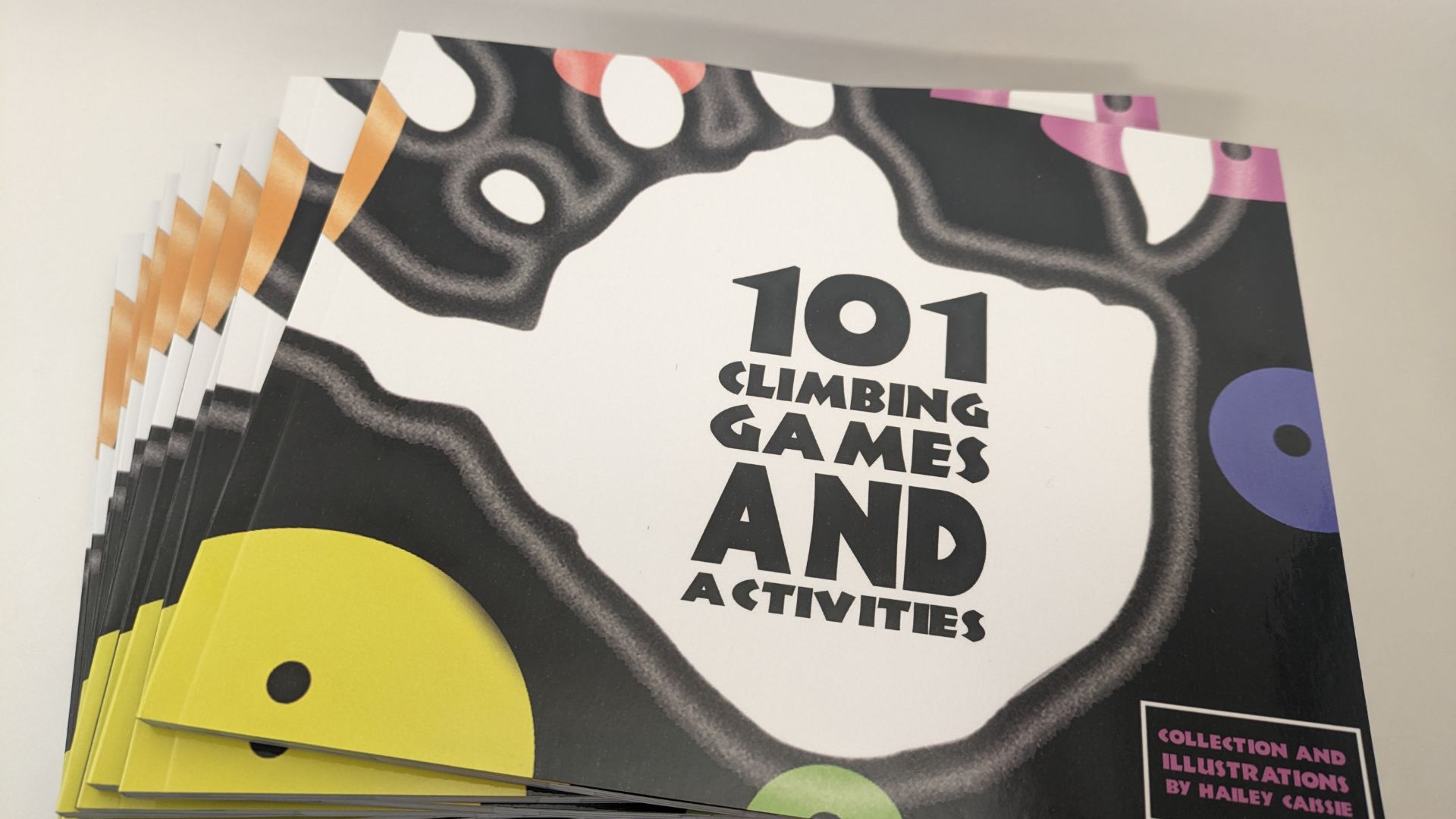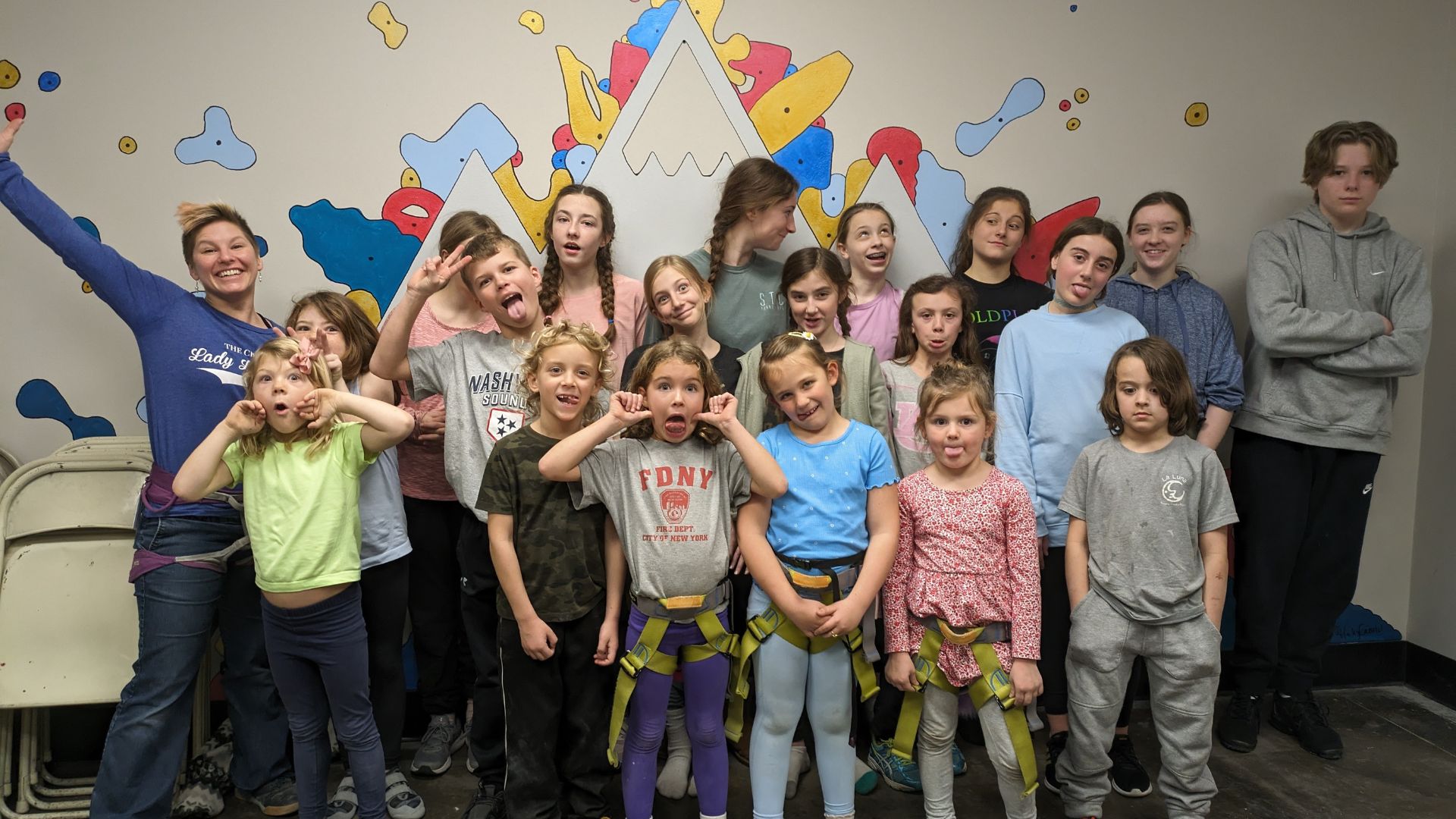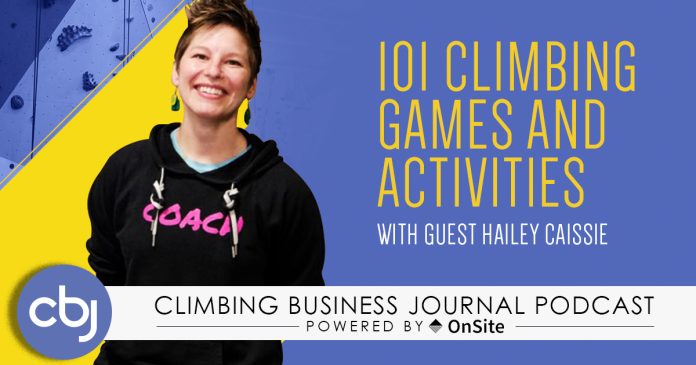
On this episode of the Climbing Business Journal Podcast, host John Burgman speaks with Hailey Caissie. Hailey is the Programs Manager at The Crag in Tennessee, and she is also the author of 101 Climbing Games and Activities. So, for anyone who struggles to think of games to play in youth programs or even adult programs, this book may be an interesting resource. It’s a tool that could be helpful to coaches, parents, youth athletes, managers, and simply anyone who climbs. John and Hailey discuss the writing process a bit and how the book came to be, and Hailey shares several games covered in her book, from Blind Climb to Tug of War.
Thank you OnSite for your support!
And thank you Devin Dabney for your music!
Timestamps
00:00 – Intro
04:40 – The Tennessee gym scene
06:31 – New gym challenges
07:44 – Caissie’s climbing history
11:06 – The book’s origin story
14:18 – The impetus for the book
16:07 – Youth age gap considerations
18:25 – Managers and coaches working in harmony
23:17 – Handling wild youth climbers
27:05 – Book sections
28:22 – Strategy games
31:18 – Community input
32:46 – From idea to inception
34:45 – Climbing book publishers
36:00 – Caissie’s writing routine
37:53 – Public responses to the book
45:14 – Caissie’s favorite games
51:57 – Adaptive games
56:14 – Working with youth climbers with ADHD
01:01:36 – Contacting Caissie
01:03:28 – Closing
Abridged Transcript
BURGMAN: What was the hardest part about opening [The Crag Franklin’s] relocation?…
CAISSIE: Well, I’ll tell you, the fun part was designing and thinking about all the programs that I wanted to have there, and just imagining all these kids that I’m going to get to teach and do camps with. So, that was definitely the fun part. The hard part, and I think a lot of gym members can relate to this, is the city of Franklin and all of its hoops to jump through. And there was a plane crash with the owner of the building the day that we signed the lease. So, they perished and we had to figure out reallocation and dive through those hoops and wait for lawyers. And there was a huge hurdle to jump through and it was just a freak accident, but that was definitely one of the challenges.
…Tell me about how you got into climbing in the first place. And tell me, by extension of that, if your initial entry into it did not involve gyms, how did you find your way to the gyms?
Thank you for asking. I first fell in love with climbing with my cousins in the woods of East Tennessee. We lived a little bit set back, at the foothills of the Appalachians, and there were a lot of places to romp through the woods and play and explore. And we found a cliff, we found probably a 30-foot by 100-foot cliff in our woods. And so, my cousins, who were 13 and 14 years old—and I must have been 8 or 9 years old—were all in, ready to learn about tying anchors and creating systems. I remember they made me a little Swiss seat out of rope that was so uncomfortable. And I didn’t care, I was in love with it. I wanted to climb as high and as often as I could. That’s where I spent most of my summers as a kid, romping around the woods, getting dirty, cutting my hands, just loving it.

…How did your climbing intersect with the writing?
It’s a great question. So, when we built this climbing gym together, I saw a lot of kids coming in, and I was like, “Oh, gosh, these kids have to learn how to climb.” So, I put together a curriculum for the first time. I just asked a bunch of teachers how to do it, and it’s gotten better and better and better. After every practice, I would debrief with my coaches, and I’d learn how to teach better. And teaching better means being concise and being clear and not having too many rules for a game. So I learned, firstly, through curriculum. I’ve written my whole life; I’m a journal keeper, and I’ve always had a little bit of poetic art. After I started teaching these kids and seeing the benefits of it, I started recording these games…
Kids are little geniuses running around, and they’re very creative problem solvers. So, I feel like I’ve been inspired by kids over and over and over again, and they’ve taught me over and over not to overestimate them. So, if someone has a great idea, even if they’re eight, I’m likely to hold onto it. And so, when I had all these games, and I told [one of the youth climbers in our programs], “You know, I think I’ve always wanted to write a book one day,” she said, “You should do it!” And I said, “Ok, I think I have about 100, I’ll call it ‘100 Climbing Games.’” And she said, “You should call it ‘101 Climbing Games and Activities.’” I said, “Ok, you’re brilliant kid, I got you.” [laughs] So three years later, it’s finally out. It took a while to put it together, but I’m a patient woman, and I’m dedicated, so I think it’s doable. I think a lot of other people have a ton of things, a ton of gifts, a ton of resources that they can share with the rest of the community, too.
…Is there something that you wish coaches knew from the managerial side? And is there something that you wish managers knew about the coaching side? How can we help bring those two sides together in harmony?
…I have seen a couple of gyms do it really well. And one of the things that I’ve seen done really well is, on the front end, with a little bit of design. So, having a segmented place specifically for teaching: this is where classes happen, this is where warmups happen, this is where the kids’ zone is. Secondly, I have seen a lot of coaches do a great job at group management. So, generally, it’s around a six-to-one ratio, depending on the kid’s age. So, each coach is in charge of keeping these six kids together, and that’s also a pretty good number for playing a game.
And then, we have to have a little bit of overall awareness. All of us are members, kids are members too, so they get just as many rights to the areas as everyone else. But, if you do want to take an area on specifically for your team or league, it can be helpful to have just a little sign up: “League practice from six to seven o’clock tonight.” That way, it’s communicated with the rest of the members that, “Ok, this will be open from seven, at least they won’t be running underneath me during my project.” And teaching etiquette is a huge part of it as well. So, when I bring kids over to the boulder, every time, even if they’ve been in it for two years, I have them tell me the three golden rules, and one of them is watching zones, not running, and coming down properly.
…How do you handle a particularly wild bunch of kids, in terms of just team practice, activities, games, that sort of thing?
Awesome, that’s a great question. So, usually if I get a wild bunch of rowdy, wily coyotes in, we’re going to do something for mind and body and listening. We’re going to get them on a line, like the barrier between the concrete and the carpeted areas. We’re going to get them all somewhere, in some sort of order. I might even have them line up from tallest to shortest, from birthdays, from January to December, because then they’re going to start using their higher functioning, their left-side brain stuff. And then from there, we’re going to do something a lot like Simon Says. So, then I’m getting them to listen over and over: “Touch your toes, touch your nose, hands in the air, move them around like you just don’t care.” Now they’re listening, and now I see that they have energy and power. So, I’m going to go over to the power or endurance or strength section of the book and we’re going to wear them out just a teeny tiny bit, just enough for them to focus. We’re going to do something like Capture the Flag, which is a great game…From the endurance chapter, I would recommend Tag…This will get them sweaty and hot and headed to the water fountain pretty quick. Now they’re ready to listen to the actual instruction…
…Let’s kind of go back to the book, the process of putting this together and getting it published. Specifically, you get these activities from a lot of different sources, different coaches, and then what do you do? What is the process for getting a book published in the climbing industry?…
Well, I’ll give you my advice from my experience, and that’s to go to the publisher first. I wrote the book first: I illustrated, I made it beautiful, I did all the edits, and then all the while doing research on what publisher I thought would be best for my brand and most likely to take me and who had the best connections. And finally, I picked one, and it needed to be in a different format, so there was a lot of rework to do after that. So, I’m going to say go to the publisher first, because they’re going to be your best resource for guiding your writing, finding your market, putting it in the right format. And then they’ll have a ton of other resources, too, when it comes time for marketing and sales…And you get to know them, whether or not you want to work with them as a business partner…You got to make sure the relationship works first before you get locked into it.

…Are there any activities, games that you haven’t mentioned, that you consider really effective or a particular favorite for some reason? I’d be really curious to hear some more…
…We’ve got one called King Swing, which is an absolute blast, and you do need a little bit of space for it. But King Swing is where we climb up a pretty approachable route on a rope that’s two stations over, so there’s probably 10 or 15 feet between the anchor it is on and the route that they’re climbing, because what we’re doing is creating a pretty large swing when they hop off the route. So, they’re doing the “king swing,” and we do this every time we have a birthday on the team, so it’s like jumping into your next year…
The most effective one—this is by far my favorite game. When I meet a group of kids for the first time, some of them are new, some of them have been climbing for a few years, I want to see what they already know. So, we play Squish. Squish is a game usually in front of a traverse, but it can definitely be done on the boulder. And it’s kind of a listening game and kind of a technique game, because I start with, “When I say ‘squish,’ and only when I say ‘squish,’ will your feet move off of the black line. You’ll go to the wall, get your hands and feet on, and listen for commands. We’re going to review the commands first, so I can see if you know the techniques. We’re going to match hands, we’re going to side pull, we’re going to backstep, we’re going to smear, we’re going to switch feet again,” things like this. And then we can add some caveats and rules, like if you fall off, you’re out, or maybe you get two falls. But then I’ll say, “Alright, you ready to play?” And I’ll say something like, “Ready, set, go.” The kids that run to the wall are not listening. “When I say ‘squish,’ and only when I say ‘squish,’ your feet move off the line.” Because I need them to listen for this one. And we can practice fundamental skills like edging and switch-foot and smearing and drop knee and heel hook…
How can some of these games be adapted to special needs kids, or maybe kids that want to do adaptive climbing, adaptive competition, or something like that? Are there ways to tweak some of these games so they are appropriate for different kids with different needs?
…Climbing is for everyone, and it should be accessible to everyone. Just because you’re in a chair does not mean that you can’t climb, and it doesn’t mean that you can’t play and have fun with your friends, too. So, what I did was I picked out a few games from each one of the chapters that I thought would be most appropriate to start with, in the IFSC adaptive climbing category. So, we’ve got reduced power, upper extremity amputee, lower extremity amputee, and visual impairment. And so, let’s go to visual impairment for a moment. One of the games is super fun. It’s called Sumo, and this is a floor game. This is a great one to warm them up, a team icebreaker, or if their hands are really tired. What we’re going to do is stand about a step away from each other, with your feet on the floor touching each other, or not touching but facing each other. Your hands are going to be up in the palm shape, with your fingers together. Only palms can touch palms. We cannot interlock fingers or grab onto one each other. And what we’re trying to do is push against one another to knock the other off balance. So, we’re starting to learn a little bit about center of gravity, we’re starting to learn about pressure on our feet, and we’re learning about how to compensate for balance that’s been thrown off…
This kind of maybe pertains to what we talked about a little bit earlier with the kids that are a little wild. But what do you do with kids that are ADD, ADHD? Because I know that’s another challenge of coaching a group of kids. You’re going to have some kids that have a lot more energy than others….
It’s going to be so individualized. But I’m going to say the parents on your team; relationship with the parents is fundamental, number one. They will tell you what motivates the kid. They will tell you appropriate consequences for not listening. They know their kid better than anybody. So, get the parents on your team, firstly. Secondly, I’m going to say meet them where they are. If I have a kid with a ton of energy and not a lot of focus, awesome. We’re going to be doing laps. We’re going to do speed. I’m going to get you into speed climbing: “You ever see speed climbing in the Olympics? It’s the best thing in the whole wide world. You’re going to be great at it.” Meet them where they are, meet their energy and direct it. Put it into a place, connect and redirect…
…I want people that are listening to this to go out and get this book. So, can you tell them if they want to buy it, where can they go if they want to correspond with you?
…If you want a few games to help enliven your youth program, your summer camp, gosh, anything like that…go to BookBaby.com, look for 101 Climbing Games and Activities. If you forget all of that, go to Amazon. It’s there too, but the percentages are nicer over at BookBaby. If you forget that, DM me on Instagram [@HaileyCaissie] and we will figure it out. I also do wholesale, and I am happy to get a few in your gym if you think that the parents of your youth team members would like it, too.

John Burgman is the author of High Drama, a book that chronicles the history of American competition climbing. He is a Fulbright journalism grant recipient and a former magazine editor. He holds a master’s degree from New York University and bachelor’s degree from Miami University. In addition to writing, he coaches a youth bouldering team. Follow him on Twitter @John_Burgman and Instagram @jbclimbs. Read our interview Meet John Burgman, U.S. Comp Climbing’s Top Journalist.










